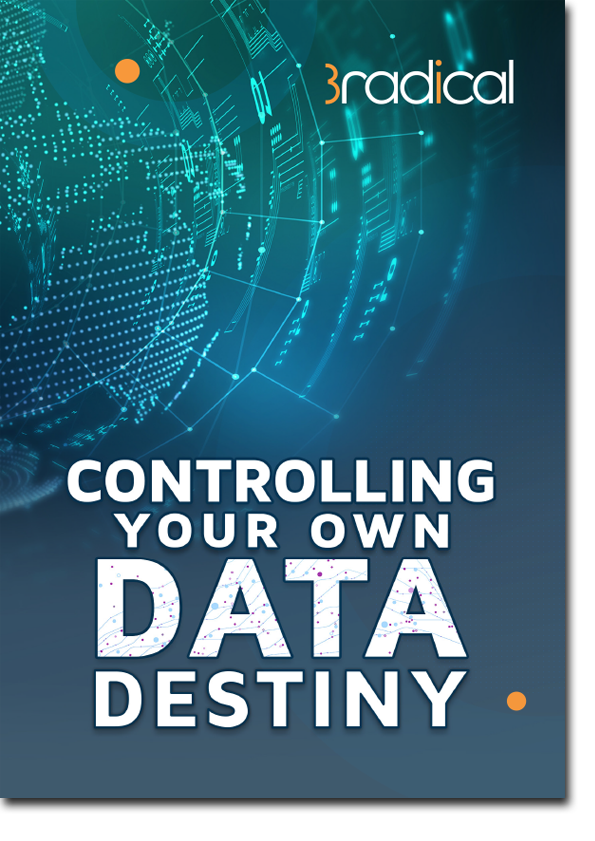Editor’s Note: The text of this article originally appeared in a white paper from Steve Quast and 3radical that details the value of, and the mechanics of controlling your own customer data destiny. That report can be downloaded here.
Data is vital for engaging customers, identifying prospects and fostering meaningful stakeholder relationships. It is the lifeblood of organizations.
Marketers have traditionally bought a lot of data. They’ve been able to purchase aggregated information on demographics and consumer behavior but that’s changing. The sources that have become relied upon are unlikely to be available in the near future and long-established data collection methods are facing increased scrutiny both domestically and internationally.
By Steve Quast
In Europe, General Data Protection Regulation (GDPR) requires organizations – amongst many other things – to obtain explicit consent when gathering and processing data from individuals. The U.S. is catching up and there is legislation in California today – the California Consumer Privacy Act (CCPA) – giving citizens the right to know their personal data is being collected, the right to have their data deleted and to opt out of the sale of their personal information. Nine states are debating similar legislation and 25 others are considering privacy law in some form.
Laws and regulation are only passed when there is demand and support. Make no mistake about it, politicians wouldn’t be implementing legislative change without pressure from their constituents. There have been recent high-profile data breaches that have shown the public their personal data is vulnerable to hacks. Consumers increasingly recognize the value of their data and are holding brands accountable when its security is not made a priority.
WHY IT’S IMPORTANT TO CONTROL YOUR OWN DATA DESTINY
If I headed up a marketing organization, I’d be concerned with how I was going to obtain data. Can marketing afford to lose its understanding of consumers? What they’re interested in? How much they’re spending? Their feelings towards competitors?
If anything, consumers today expect a higher level of service and personalization than ever before. Therein lies the challenge; increasing consumer expectations in parallel to rising customer data privacy concerns. On the surface, marketers are being expected to do more with less.
However, privacy legislation does not necessitate the end of the data collection. ‘First Party Data’ such as purchase activity, which is vital to understanding the lifecycle of the customer is still available, as is ‘digital exhaust’ information (the trail of data left by online activities). It’s that which is needed to address questions only answerable with Second and Third-Party data, such as share of wallet, identification of personas, and alignment of content with life stage that will become increasingly scarce.
So, the challenge for companies is how to control their own customer data destiny while adhering to the new regulations. When brands control their own data, marketers are guaranteed access when they need it. Otherwise, they can be dangerously out of control.
Surveying is a possibility; it’s a flexible model that can be used to capture a range of data, including demographics and attitudinal data. Due to cost however, it’s often difficult to survey more than a small percentage of consumers. Another option is the ‘Preference Center’. By design, these tools provide insights into how customers want to engage with an organization. However, often they too are only used in small numbers. Marketers will need other options to motivate consumers to share this type of data, while accounting for privacy concerns.
HOW TO DO THIS
Gamification, the application of game- design, behavioral economics and motivational psychology in ‘non-game’ contexts, is being used in online experiences to achieve remarkable things. It provides a way of collecting data by engaging consumers through clear value exchange.
People not only consent, but volunteer data in return for better experiences and monetizable incentives. This is referred to as ‘Earned Data’ (versus First, Second or Third-Party). It’s transparent and consumers only volunteer information when they feel like what they’re receiving in return is worthwhile.
The open and honest nature of the approach presents opportunities to strengthen relationships and gain data that has otherwise been hard to come by.
People not only consent, but volunteer data in return for better experiences and monetizable incentives.
One of the many industries that is embracing gamification is casual dining. Initial customer data might be obtained through branded-games, where customers play to win vouchers redeemable in- restaurant, the learnings are used to not only better understand and improve the customer
experience but to establish a relationship with the brand. “If you tell us your dietary requirements, we’ll give you three shots at winning prizes tailored to you,” is a simple example. Once those give and take relationships are established, it becomes easier to ask for more detailed information, such as, “Would you like to be notified when other vegan options are added to the menu?” “How was your experience?” “What do you want more of?”
The information gleaned through such dialog helps brands better understand where they excel from the consumer’s perspective and, equally importantly, where they are failing. These insights provide information relevant to marketing communication strategies and ultimately help to fuel stronger sales and return on investment (ROI).
THE IMPORTANCE OF TRANSPARENCY AND CONSENT DRIVEN/ EARNED DATA
The future of data collection will focus on gaining consented data from consumers directly. Rather than web scraping, etc., it will be more transactional, and transparent.
The practice should be more sophisticated than observing consumer actions in isolation and then making assumptions. Using search data to serve ‘related’ ads can be superficial, ineffective and annoying to consumers who haven’t asked to be engaged in such a way.
With earned data, brands get to ask the important questions, which have not always been easily obtained in traditional data collections models. Answers as to where the consumer is in the purchase lifecycle for example, can be invaluable. It offers the opportunity to get more detail. This approach is similar to the relationships of old where store owners would truly get to know their customers. Customers would welcome questions and keep returning because of the care being shown. The store took a genuine interest in how they could best serve their customer. In such relationships, consumers are not going to be offended or inconvenienced when engaged because the focus is on improving their experience.
The importance of transparency should also not be underestimated. I am more receptive to advice and input that I’ve asked for. People often find unsolicited adverts based on their searches ‘creepy’, and find false assumptions infuriating. They may not want a brand to know what they’re looking for (they might not know themselves) and interjecting too early rarely benefits anyone.
HOW EARNED DATA CAN BE USED
In the acquisition stage, marketers ‘rent’ targets from list owners or data co-ops. They promote generic acquisition pieces and those that respond become customers. Applying an ‘earned data’ approach at this stage uses gamification to more effectively engage those targets. Drawn in by the lure of playing for rewards, questions, such as: “Are you interested in us?” or “Would you ever respond to a direct mail piece?”, can be asked to understand if the prospect is likely to engage. If the person responds “no”, it avoids wasted effort and spend. This is particularly useful in the direct mail world, where the costs can quickly consume big chunks of marketing budgets.
New avenues become available when consumers are being properly incentivized to provide insights. Rather than relying on historical purchase data, brands can find out future purchase intentions. If a customer hasn’t purchased for a while, marketers can ask them why. For example, the brand can provide a discount to attract prospects that share that cost is a barrier to purchase.
In digital acquisition efforts, dynamic content can be used to customize content based on earned customer data gained via online experiences and value exchanges.
The value of earned customer data is the context where it’s being provided. The information is shared directly by the consumer versus assumed by the brand. For example, information scraped from an online search for a certain brand of shirt may be interpreted that the searcher likes that brand. In reality they could have been searching for a present that has now been purchased, ending the engagement. This is a simple but important point. Who hasn’t been followed around online by variations of products they have no interest in buying because of their searches?
THE ‘RED CAR ANALOGY’
Perhaps the best way to illustrate why brands should stop assuming and start asking is what I call ‘The Red Car Analogy’. If I searched for a specific red car on my laptop, I’d likely be served ads for red cars from other brands on all my devices.
It’s no surprise that this feels a little invasive. It also makes a lot of assumptions as to what my search says about me as a consumer; am I just browsing? Am I seriously considering a purchase? Was the search completely unrelated to purchase intent?
It’s the equivalent of visiting the dealer- ship, glancing at a red car and the sales- person coming at me with the hard sell. The last thing most people want is pushy salespeople jumping on them when they’re just browsing. Marketers can be guilty of doing just that using scraped customer data. They are gambling that, through volume, they will reach the people for which it’s relevant. That’s far from the sophisticated or personalized approaches professional marketers strive for.
Valuable data is shared willingly. It’s the equivalent of the dealership gathering more information to figure out what the consumer actually wants and then progressing through the journey together. That data must then be used to genuinely help the individual. The moment the dealership starts pushing options that have nothing to do with the search is the moment the consumer considers ending the engagement.
KEY TAKEAWAYS
- It’s not a case of if, but when this regulation hits. When it does, it’s going to handcuff what type of data can be captured on consumers. Organizations that gather the data relied upon by brands are going to have to rethink what they’re offering as many sources will have limited scale and scope.
- People across the world are increasingly conscious of the way their data is handled. For brands that have done things a certain way for a long time, the changes can be daunting. This is indeed a time of change, but one that should be viewed as an opportunity rather than a burden. Data may be harder earned but it is also likely to be much more robust – and that’s pretty exciting.
- Gamification techniques provide a way for marketers to acquire information on individuals and adhere to the strictest privacy laws because the individual is not just consenting, they’re proactively volunteering data.
 Steve Quast holds a degree in math and economics and has spent over 20 years using data in analysis and predictive analytics to guide marketing campaigns. More on Steve’s background here.
Steve Quast holds a degree in math and economics and has spent over 20 years using data in analysis and predictive analytics to guide marketing campaigns. More on Steve’s background here.
3radical is the leader in audience engagement and earned data solutions with offices in the United Kingdom, North America, and Singapore. Its Voco platform allows individuals to interact with organizations on their own terms. 3radical’s real-time decisioning engine is able to combine game science theory, data accumulated from billions of interactions, and immediate self-reported data, resulting in the optimum blend of interactive content, rewards incentives and channel for each engagement. The permission-based, earned data is willingly and transparently provided in return for a mutual value exchange, and can be used to improve the relationship of the individual with the organization across all channels, and by informing product and service development. Go here for more information about 3radical.
is the leader in audience engagement and earned data solutions with offices in the United Kingdom, North America, and Singapore. Its Voco platform allows individuals to interact with organizations on their own terms. 3radical’s real-time decisioning engine is able to combine game science theory, data accumulated from billions of interactions, and immediate self-reported data, resulting in the optimum blend of interactive content, rewards incentives and channel for each engagement. The permission-based, earned data is willingly and transparently provided in return for a mutual value exchange, and can be used to improve the relationship of the individual with the organization across all channels, and by informing product and service development. Go here for more information about 3radical.
Download the full white paper: “Controlling Your Own Data Destiny” here.
Photo by Kurt Cotoaga on Unsplash.












